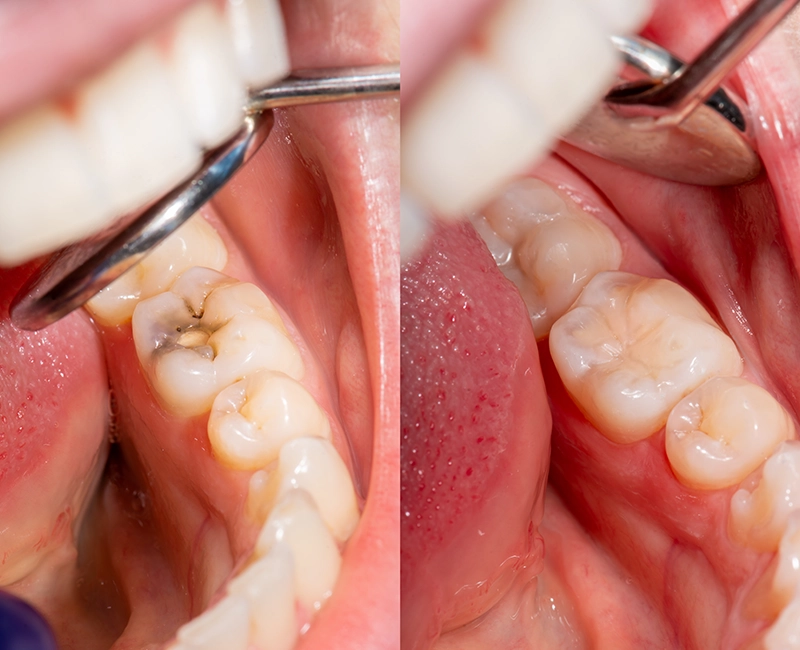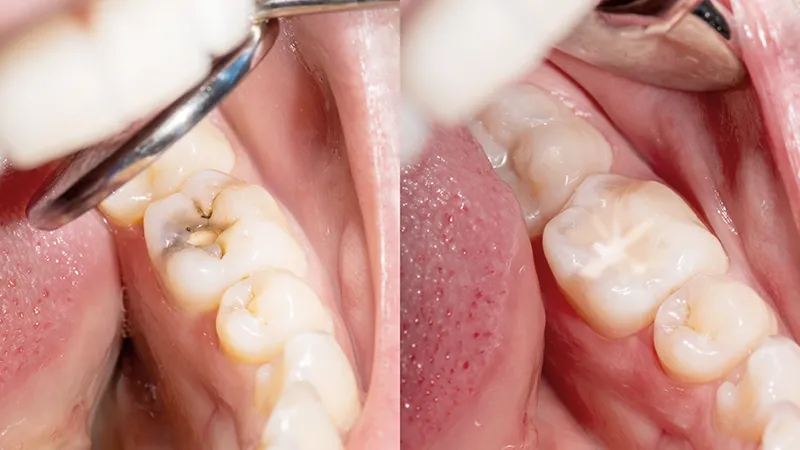Dental Fillings
Durable, cost-effective tooth repairs

Dental Fillings
Durable, cost-effective tooth repairs
Seamless fillings for confident smiles
At Alma Dental Surgery, we see more than a hole—we see your whole smile. That’s why every restoration we do is designed not just to fix a problem, but to strengthen, protect, and blend naturally with your smile. That’s why we use high-quality, tooth-coloured materials and the latest techniques to provide fillings that are not only durable but also genuinely unnoticeable.
Whether you’re dealing with a cavity, a chipped tooth, or worn enamel, our experienced team will carefully assess your needs and recommend the most effective, comfortable solution. Our priority is to preserve as much of your natural tooth as possible while restoring its function, integrity, and appearance—for results that look and feel just right.
Dental fillings
Dental fillings are used to restore teeth that have been damaged by decay, cracks, or everyday wear. By sealing the affected area, a filling helps prevent further damage while restoring the tooth’s strength, function, and appearance.

Dental fillings are used to restore teeth that have been damaged by decay, cracks, or everyday wear. By sealing the affected area, a filling helps prevent further damage while restoring the tooth’s strength, function, and appearance.
When you might need a filling
You may benefit from a dental filling if you notice any of the following:
✔ Sensitivity to hot, cold, or sweet foods and drinks
✔ Visible holes or dark spots on your teeth
✔ Pain or discomfort when chewing or biting
✔ Chipped, cracked, or worn-down teeth
✔ Rough edges or surfaces that feel different
✔ Existing fillings that are damaged or failing
Early treatment is your key to long-lasting oral health. Left untreated, even a small cavity can progress into a more serious problem, possibly requiring a root canal or tooth extraction. A simple filling can help preserve your natural tooth and prevent more complex treatment down the line.
Common types of fillings
Composite (tooth-coloured) fillings
Made from a strong resin material, composite fillings blend seamlessly with your natural teeth. They’re bonded directly to the tooth surface, providing both strength and aesthetics—ideal for small to moderate restorations on front and back teeth.
Glass ionomer fillings
These fluoride-releasing materials are typically used on non-biting surfaces, root surfaces, or children’s teeth. While not as strong as composite, they offer protection against further decay and a natural appearance.Ceramic (porcelain) fillings
Crafted using CAD-CAM technology, ceramic fillings are known for their lifelike appearance, high durability, and resistance to staining. They’re a popular choice for larger fillings or visible areas where aesthetics matter most.Amalgam (silver) fillings
Once a standard option, amalgam fillings are durable and cost-effective, especially for back teeth. However, due to their metallic appearance, they are now less commonly chosen in favour of more natural-looking materials.Gold fillings
Renowned for their exceptional strength, durability, and biocompatibility, gold fillings can last decades with proper care. They are highly resistant to wear and corrosion, making them ideal for patients who value longevity over aesthetics.What happens during a dental filling?
Getting a dental filling is typically quick and virtually painless. Here’s what to expect during your visit:
Step 1: Comprehensive examination
We begin with a thorough assessment using visual checks, digital X-rays, or intraoral scans to identify decay or damage and determine the best treatment.Step 2: Numbing and preparation
Local anaesthetic is used when needed to ensure your comfort. We then gently remove the decayed or damaged part of the tooth, preparing it for the filling.Step 3: Filling application
The chosen material is layered into the prepared area. Composite fillings are cured using an LED light and shaped to match your tooth’s natural contours.Step 4: Final touches
Finally, we polish the surface and check your bite, making any necessary adjustments for a natural feel and smooth finish.How to look after your dental fillings
Good habits go a long way in protecting your dental work and overall oral health:
1. Keep up with twice-daily brushing using fluoride toothpaste
2. Floss each day to keep the areas around your fillings clean
3. Cut back on sugary or acidic foods that can cause decay
4. Don’t skip your dental check-ups and cleans
5. If you grind your teeth at night, ask us about a custom night guard

When fillings aren’t the best option
While dental fillings are ideal for repairing small to moderate areas of decay or damage, they may not be suitable for everyone. In cases where the tooth structure is severely compromised, a larger and more durable restoration—such as an inlay, onlay, or crown—may be more appropriate to restore strength, function, and long-term protection.
That’s why we perform a comprehensive assessment before recommending treatment. By evaluating the extent of the damage, your bite, and overall oral health, we can determine the most effective and lasting solution for your individual needs. Our goal is always to preserve as much of your natural tooth as possible, without compromising on durability or aesthetics.
Restore and protect your smile—gently
Tooth sensitivity, discomfort, or a small cavity might not seem urgent—but early, minimally invasive care can make all the difference. At Alma Dental Surgery, we treat problems before they grow, using techniques that preserve your natural tooth structure and restore your smile with precision and care.
Call us on (08) 9227 6468 or book online to schedule your visit. We’re here to help you feel comfortable, confident, and completely looked after with cost-effective dental care.

